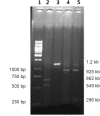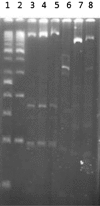N-acetyltransferase 2 (NAT2) gene polymorphism as a predisposing factor for phenytoin intoxication in tuberculous meningitis or tuberculoma patients having seizures - A pilot study
- PMID: 27488001
- PMCID: PMC4989831
- DOI: 10.4103/0971-5916.187106
N-acetyltransferase 2 (NAT2) gene polymorphism as a predisposing factor for phenytoin intoxication in tuberculous meningitis or tuberculoma patients having seizures - A pilot study
Abstract
Background & objectives: Simultaneous administration of phenytoin and isoniazid (INH) in tuberculous meningitis (TBM) or tuberculoma patients with seizures results in higher plasma phenytoin level and thus phenytoin intoxication. N-acetyltransferase 2 (NAT2) enzyme catalyses two acetylation reactions in INH metabolism and NAT2 gene polymorphism leads to slow and rapid acetylators. The present study was aimed to evaluate the effect of allelic variants of N-acetyltransferase 2 (NAT2) gene as a predisposing factor for phenytoin toxicity in patients with TBM or tuberculoma having seizures, and taking INH and phenytoin simultaneously.
Methods: Sixty patients with TBM or tuberculoma with seizures and taking INH and phenytoin simultaneously for a minimum period of seven days were included in study. Plasma phenytoin was measured by high performance liquid chromatography. NAT2 gene polymorphism was studied using restriction fragment length polymorphism and allele specific PCR.
Results: The patients were grouped into those having phenytoin intoxication and those with normal phenytoin level, and also classified as rapid or slow acetylators by NAT2 genotyping. Genotypic analysis showed that of the seven SNPs (single nucleotide polymorphisms) of NAT2 gene studied, six mutations were found to be associated with phenytoin intoxication. For rs1041983 (C282T), rs1799929 (C481T), rs1799931 (G857A), rs1799930 (G590A), rs1208 (A803G) and rs1801280 (T341C) allelic variants, the proportion of homozygous mutant was higher in phenytoin intoxicated group than in phenytoin non-intoxicated group.
Interpretation & conclusions: Homozygous mutant allele of NAT2 gene at 481site may act as a predisposing factor for phenytoin intoxication among TBM or tuberculoma patients having seizures.
Conflict of interest statement
Figures





Similar articles
-
The role of isoniazid dosage and NAT2 gene polymorphism in the treatment of tuberculous meningitis.Front Immunol. 2025 Jan 20;15:1535447. doi: 10.3389/fimmu.2024.1535447. eCollection 2024. Front Immunol. 2025. PMID: 39902038 Free PMC article.
-
Phenotypic interaction of simultaneously administered isoniazid and phenytoin in patients with tuberculous meningitis or tuberculoma having seizures.Eur J Pharmacol. 2013 Aug 15;714(1-3):157-62. doi: 10.1016/j.ejphar.2013.05.032. Epub 2013 Jun 20. Eur J Pharmacol. 2013. PMID: 23792142 Clinical Trial.
-
Allele-specific detection of isoniazid metabolism modulating variants of N-acetyltransferase 2 enzyme and their frequencies in the Bangladeshi population.Gene. 2025 Jul 15;957:149480. doi: 10.1016/j.gene.2025.149480. Epub 2025 Apr 9. Gene. 2025. PMID: 40204038
-
Interethnic and intraethnic variability of NAT2 single nucleotide polymorphisms.Curr Drug Metab. 2008 Jul;9(6):487-97. doi: 10.2174/138920008784892155. Curr Drug Metab. 2008. PMID: 18680468 Review.
-
Structure/function evaluations of single nucleotide polymorphisms in human N-acetyltransferase 2.Curr Drug Metab. 2008 Jul;9(6):471-86. doi: 10.2174/138920008784892065. Curr Drug Metab. 2008. PMID: 18680467 Free PMC article. Review.
Cited by
-
NAT2 gene polymorphism: covert drug interaction causing phenytoin toxicity.Indian J Med Res. 2016 May;143(5):542-4. doi: 10.4103/0971-5916.187101. Indian J Med Res. 2016. PMID: 27487996 Free PMC article. No abstract available.
-
Pharmacogenomic heterogeneity of N-acetyltransferase 2: a comprehensive analysis of real world data in Indian tuberculosis patients and from literature and database review.Ann Med. 2025 Dec;57(1):2478316. doi: 10.1080/07853890.2025.2478316. Epub 2025 Mar 26. Ann Med. 2025. PMID: 40138446 Free PMC article.
-
The role of isoniazid dosage and NAT2 gene polymorphism in the treatment of tuberculous meningitis.Front Immunol. 2025 Jan 20;15:1535447. doi: 10.3389/fimmu.2024.1535447. eCollection 2024. Front Immunol. 2025. PMID: 39902038 Free PMC article.
-
The landscape of very important pharmacogenes variants and potential clinical relevance in the Chinese Jingpo population: a comparative study with worldwide populations.Cancer Chemother Pharmacol. 2024 May;93(5):481-496. doi: 10.1007/s00280-023-04638-0. Epub 2024 Feb 1. Cancer Chemother Pharmacol. 2024. PMID: 38300251
-
Pharmacogenetic Analysis of an 8-Year Old Girl with Reye Syndrome Associated with Use of Naproxen.Am J Case Rep. 2024 Feb 5;25:e942242. doi: 10.12659/AJCR.942242. Am J Case Rep. 2024. PMID: 38311849 Free PMC article.
References
-
- Donald PR, Schaaf HS, Schoeman JF. Tuberculous meningitis and miliary tuberculosis: The Rich focus revisited. J Infect. 2005;50:193–5. - PubMed
-
- Kashyap R, Kainthla R, Purohit H, Taori G, Daginawala H. Tuberculous meningitis in patients without systemic focus of miliary tuberculosis. Am-Eura J Sci Res. 2007;2:33–8.
-
- Chakraborty AK. Estimating mortality from tuberculous meningitis in a community: use of available epidemiological parameters in the Indian context. Indian J Tuberc. 2000;47:9.
-
- Sumaya CV, Simek M, Smith MH. Tuberculous meningitis in children during the isoniazid era. J Pediatr. 1975;87:43–9. - PubMed
-
- Zuger A, Lowy FD. Tuberculosis. In: Scheld WM, Whitley RJ, Durack RD, editors. Infections of the central nervous system. 2nd ed. Lippincott-Raven: Philadelphia; 1997. pp. 417–43.
MeSH terms
Substances
LinkOut - more resources
Full Text Sources
Other Literature Sources
Medical
Molecular Biology Databases
